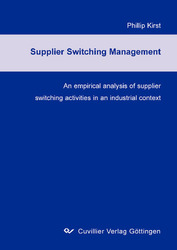| Fachbereiche | |
|---|---|
| Buchreihen (96) |
1378
|
| Nachhaltigkeit |
3
|
| Gesundheitswesen |
1
|
| Geisteswissenschaften |
2365
|
| Medienwissenschaften | 16 |
| Theologie | 57 |
| Philosophie | 102 |
| Rechtswissenschaft | 422 |
| Wirtschaftswissenschaften | 850 |
| Sozialwissenschaften | 416 |
| Sportwissenschaften | 48 |
| Psychologie | 233 |
| Pädagogik | 190 |
| Geschichtswissenschaften | 182 |
| Kunstwissenschaften | 111 |
| Kulturwissenschaften | 166 |
| Literaturwissenschaften | 117 |
| Sprachwissenschaften | 88 |
| Naturwissenschaften |
5406
|
| Ingenieurwissenschaften |
1793
|
| Allgemein |
98
|
|
Leitlinien Unfallchirurgie
5. Auflage bestellen |
|
Erweiterte Suche
Supplier Switching Management
An empirical analysis of supplier switching activities in an industrial context
Phillip Kirst (Autor)Vorschau
Inhaltsverzeichnis, Datei (33 KB)
Leseprobe, Datei (71 KB)
Current market dynamics have forced industrial companies to realign their value creation processes by concentrating on core competences. These measures have led to outsourcing of areas in which companies have no distinctive capabilities and in turn, they have extensively reduced the net added value ratio. Consequently, a substantial part of performance-critical activities are not under the control of manufactures anymore, they have shifted to suppliers. In order to maintain the influence on the supply side and on the value creation process, the concept of supplier integration has recently been strongly promoted. Supplier integration first requires the reduction of the number of suppliers, in order to intensify the relationship with some of the remaining ones. If the intensification of supplier-buyer relationships comprises mutual adjustments or specific investments, the supplier becomes integrated. The specificity of an investment refers to the degree to which a company can redeploy it to alternative uses without a sacrifice of productive value. Thus, the more specific a certain investment becomes, the lower its value is when put to another use. Integrated supplier-buyer relationships promise benefits and increased competitiveness for both parties. On the other hand, they cause dependencies and hence an inflexibility to switch, which can be a threat for the purchasing organization if the performance of the incumbent supplier weakens unexpectedly. The practical relevance of research on supplier switching relates to the dilemma of the simultaneous need for stability through supplier integration and the flexibility of the supplier structure. This work discusses the possibilities of increasing the flexibility of supplier-buyer relationships without sacrificing the benefits of supplier integration. In the perspective of the research on hand, this can be accomplished through a systematic approach to supplier switches – a business situation, which has been neglected in science and practice.
The book is organized in four main chapters and starts with the background of the relevance of supplier switching and the description of the research questions. The second chapter provides in-depth theoretical insight into supplier integration and switching and clusters activities involved in vendor replacements. Afterwards, six supplier switches of different companies are analyzed. It will finish up with good practices and possibilities for smooth and successful supplier switches.
| ISBN-13 (Printausgabe) | 3867276536 |
| ISBN-13 (Printausgabe) | 9783867276535 |
| ISBN-13 (E-Book) | 9783736926530 |
| Buchendformat | A5 |
| Sprache | Englisch |
| Seitenanzahl | 252 |
| Auflage | 1 |
| Band | 0 |
| Erscheinungsort | Göttingen |
| Promotionsort | St. Gallen |
| Erscheinungsdatum | 29.07.2008 |
| Allgemeine Einordnung | Dissertation |
| Fachbereiche |
Wirtschaftswissenschaften
|
| Schlagwörter | Lieferantenmanagement, Lieferantenwechsel, Beschaffungsmanagement, Lieferantenentwicklung. |








